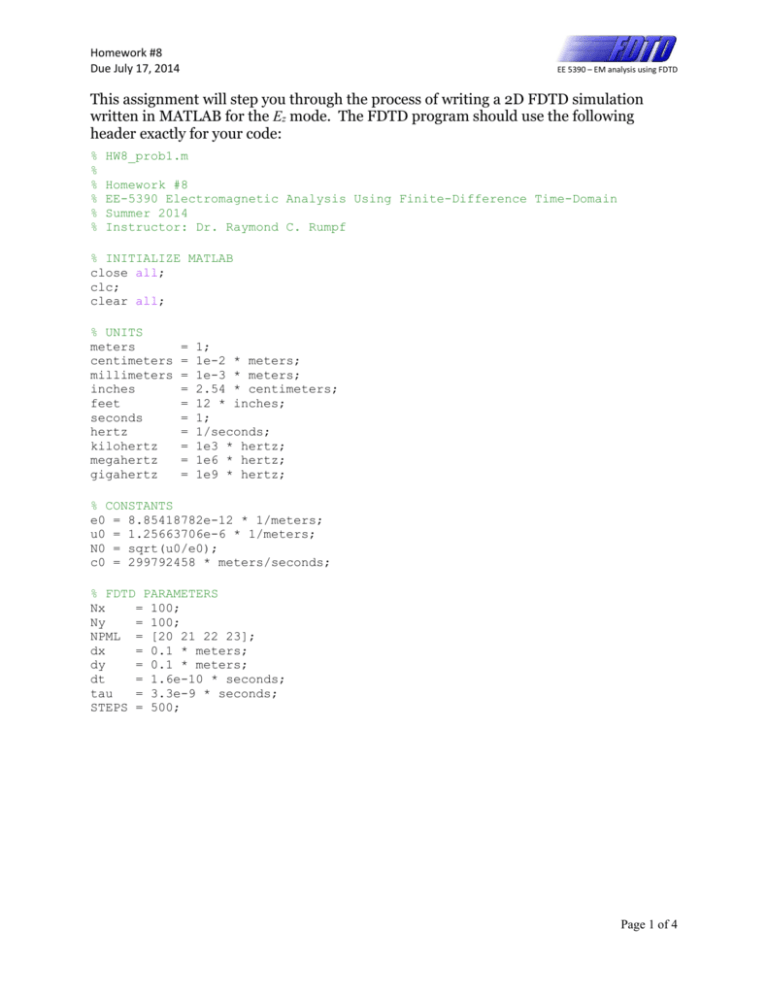
Divergence-free fields It is critical for FDTD to have the divergence-free electric and magnetic fields, with the distributed electric and magnetic charges being equal to zero, even for the point sources. In a lossy space with driving sources, Maxwells equations for the electric field (or the electric field intensity) E and for the magnetic field (or the magnetic field intensity) H in time domain have the form Amperes law modified by displacement currents SJ J HtE V =ccc (2a) Faradays law ms m J J EtH V =cc (2b) Gauss law for electric field sE c = V (2c) Gauss law for magnetic field (no magnetic charges) msH = V (2d) Continuity equation for the impressed electric current 0 = V +ccssJt (2e) Continuity equation for the impressed magnetic current 0 = V +ccmsmsJt (2e) A comprehensive theory of engineering electromagnetics may be found elsewhere. So does an equivalent magnetic conduction current describing the magnetic loss mechanism, H Jm = where is the equivalent magnetic resistivity with the units of O/m. MATLAB FDTD Fields Solver v.2-0 2011 Neva EM 4 The electric conduction current is always present in a lossy medium in the form E J o = where o is the electric conductivity with the units of S/m. Still, in practice it is often convenient to use the concept of magnetic currents (and fictitious magnetic charges). However, no magnetic charge has been found to exist in nature. The magnetic current density may be associated with an external impressed voltage. The driving sources may be also given by a (volumetric) magnetic current density msJ with the units of V/m2 and by volumetric magnetic charge density ms. Instead of volumetric currents one may consider surface currents (a blade metal dipole) or line current (an infinitesimally thin cylindrical dipole/wire).
Fdtd code in matlab free#
The free charges are free electrons in a metal or free electrons and/or holes in a semiconductor. Driving sources and lossy space The driving sources for the electromagnetic fields are given by (generally volumetric) electric current density sJ of free charges with the units of A/m2, and by volumetric free charge density s with the units of C/m3. In free lossless space (space without sources), Maxwells equations for the electric field (or the electric field intensity) E and for the magnetic field (or the magnetic field intensity) H in time domain have the form Maxwells H V equation HtE V =ccc (1a) Faradays law EtH V =cc (1b) Gauss law for electric field (no electric charges) 0 = V Ec (1c) Gauss law for magnetic field (no magnetic charges) 0 = V H (1d) 2.2. Lossless space with no sources Consider an arbitrary (inhomogeneous) medium with electric permittivity c having the units of F/m and with magnetic permeability having the units of H/m. Maxwells equations in three dimensions 2.1. Similarly, when the indexing system for the electric field is used, the nodal electric field k j izE,, is located exactly halfway between magnetic field nodes k j iyH,, 2 / 1 and k j iyH,, 2 / 1 + in Fig. For example, when the indexing system for the magnetic field is used, the nodal magnetic field k j iyH,, is located exactly halfway between electric field nodes k j izE,, 2 / 1 and k j izE,, 2 / 1 + in Fig. The system based on cube nodes (for magnetic permeability/magnetic loss values) The interleaving feature of those systems is mathematically described by half-integer indexes. References MATLAB FDTD Fields Solver v.2-0 2011 Neva EM 3 iv. MATLAB implementation of the Yee method 6. Maxwells equations in three dimensions 3. The system based on cube centers (for electric permittivity/conductivity values) 1. The system based on cube face centers (for the magnetic field) iii. The system based on cube edge centers (for the electric field) ii. Therefore, four interleaving indexing systems (i,j,k) in space may be introduced and used simultaneously: i. The magnetic permeability/magnetic loss is defined at the cube nodes (corners). The electric permittivity/conductivity is defined at the cube center(s) 4. The magnetic field is defined at the face centers of a cube 3. The electric field is defined at the edge centers of a cube 2. Yee grid A cubic Yee unit cell (uniform cell size A in all directions) is shown in Fig. Boundary conditions 32 MATLAB FDTD Fields Solver v.2-0 2011 Neva EM 2 Section I. Model of an impressed electric field or voltage source (loop of magnetic current) 26 Section VI. Model of a small coil antenna (magnetic dipole) 17 Section V. Model of a small dipole antenna (electric dipole) 13 Section IV. Yee grid and finite differences 2 Section II.

MATLAB FDTD Fields Solver v.2-0 2011 Neva EM 1 A 3D FDTD code implemented in MATLAB Contents Page Section I.


 0 kommentar(er)
0 kommentar(er)
